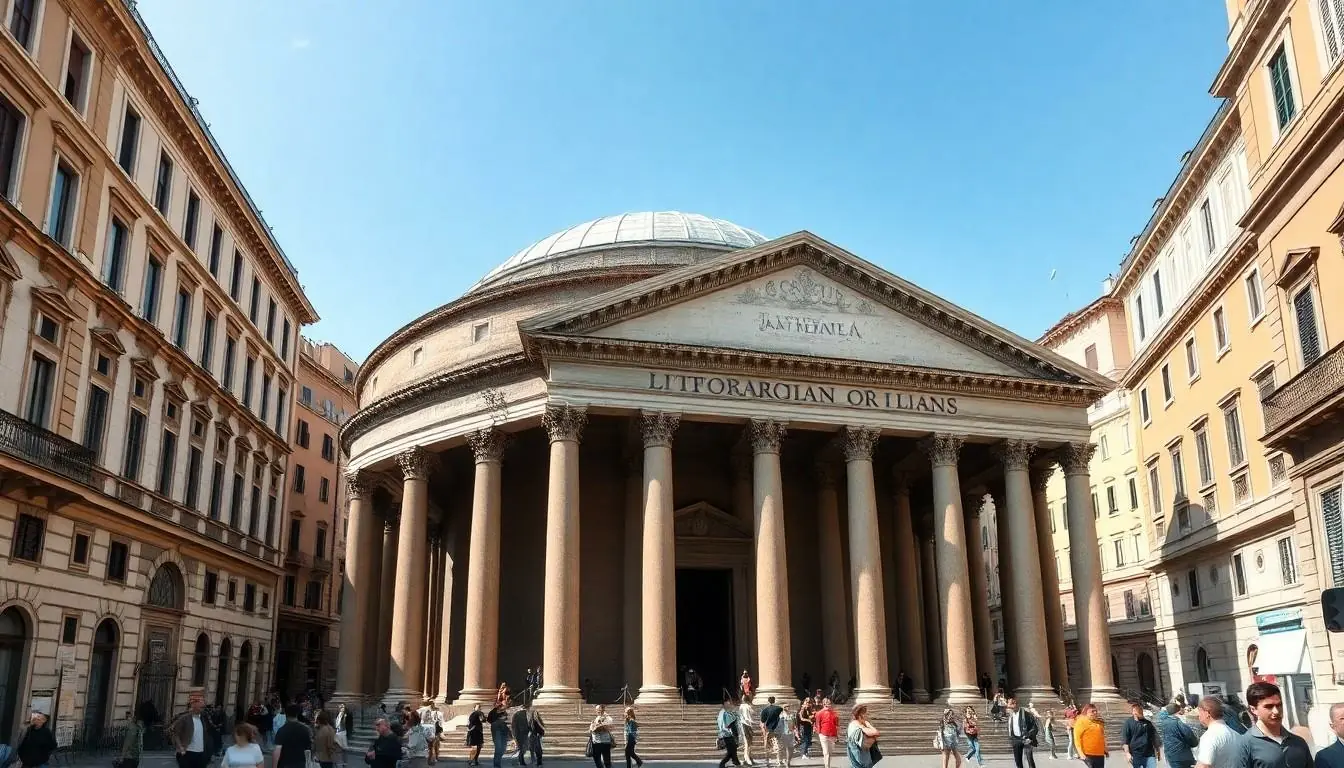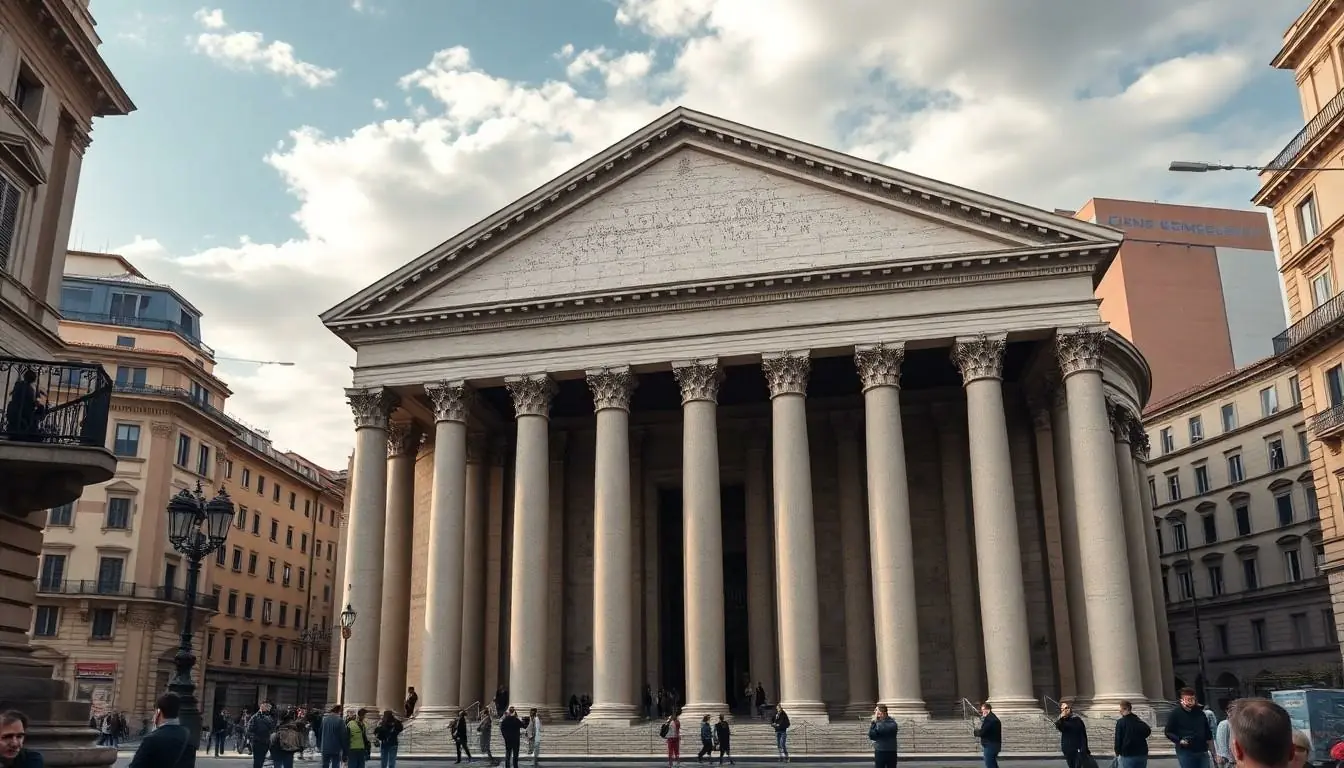Table of Contents
ToggleConcrete architecture isn’t just about pouring a slab and calling it a day. It’s a bold statement, a canvas that can shape the skyline and redefine spaces. From brutalist masterpieces to modern marvels, concrete brings a unique blend of strength and creativity that few materials can match. It’s like the superhero of building materials—durable, versatile, and always ready to save the day.
Imagine walking through a city where every structure tells a story, where the raw texture of concrete sparks curiosity. This isn’t your average construction material; it’s a design lover’s dream. In this article, we’ll dive into the fascinating world of concrete architecture, exploring its history, innovative uses, and why it deserves a spot in the spotlight. Get ready to see concrete in a whole new light—who knew a material could be so captivating?
Overview of Concrete Architecture
Concrete architecture represents a dynamic fusion of art and engineering. This building technique leverages concrete’s durability and versatility, allowing architects to create both functional and aesthetic structures. Designers frequently use this material in modern buildings, public spaces, and innovative installations.
Ancient civilizations recognized concrete’s potential. Roman architects utilized a primitive form nearly 2,000 years ago, exemplifying its long-standing significance. The Pantheon in Rome serves as a historic example, showcasing an unreinforced concrete dome that remains the largest of its kind.
In contemporary contexts, designers adopt advanced techniques to manipulate concrete. They create complex forms and textures, incorporating organic shapes that challenge traditional aesthetics. Notable projects, such as the National Museum of Qatar and the Sydney Opera House, illustrate the evolution of this medium.
Environmental considerations also influence modern concrete architecture. Sustainable practices, including using recycled aggregates and reducing carbon emissions, reflect the industry’s ongoing commitment to eco-friendly solutions. Innovations in material science lead to self-healing concrete and transparent variations that expand functional potential.
Noteworthy figures in concrete architecture, such as Le Corbusier and Tadao Ando, contribute to the discipline’s rich narrative. Their projects champion minimalist forms where space and light interact harmoniously with concrete surfaces.
Concrete architecture continually evolves, creating structures that resonate with beauty, strength, and sustainability. Building methods advance alongside design philosophies, ensuring that concrete remains at the forefront of architectural innovation.
Historical Background


Concrete architecture has deep roots, emerging as a fundamental aspect of building practices throughout history. Its durability and adaptability shaped various civilizations’ architectural identities.
Early Innovations
Ancient Romans pioneered the use of concrete, creating structures that have withstood centuries. Roman engineers utilized volcanic ash, known as pozzolana, to enhance concrete’s strength, making it ideal for monumental buildings. The Pantheon exemplifies this innovation, showcasing a massive dome that remains the largest unreinforced concrete dome worldwide. Additionally, aqueducts and amphitheaters demonstrate the material’s versatility and structural integrity. These early advancements laid the groundwork for future exploration and application of concrete in architecture.
Modern Developments
The 20th century marked a renaissance for concrete architecture, driven by technological advancements and creative experimentation. Architects like Le Corbusier utilized reinforced concrete to create bold, functional spaces. This period witnessed the rise of brutalism, characterized by raw concrete aesthetics and massive forms, as seen in structures like Boston City Hall. Incorporating innovative techniques, contemporary designs now feature complex geometries and textures, exemplified in the National Museum of Qatar. Sustainable practices have also gained importance, with developments in materials resulting in eco-friendly options like self-healing concrete, continually pushing the boundaries of architectural possibilities.
Key Characteristics of Concrete Architecture
Concrete architecture showcases unique material properties and design flexibility that have revolutionized the construction landscape. Its characteristics influence both aesthetic appeal and structural integrity, making it a favored choice among architects.
Material Properties
Concrete boasts impressive compressive strength, allowing it to bear heavy loads without compromising stability. Its durability withstands harsh weather conditions, including freeze-thaw cycles and extreme temperatures. Resistant to fire and pests, concrete structures maintain their integrity over time. Additionally, concrete’s low maintenance requirements make it cost-effective for long-term use. Environmental impact is also a consideration; innovations like recycled aggregates contribute to greener practices.
Design Flexibility
Architects enjoy considerable design flexibility when working with concrete. Various techniques, such as pouring and molding, enable the creation of complex shapes and textures. Buildings can range from minimalist to highly expressive, allowing architects to manifest unique visions. Reinforced concrete further expands possibilities, supporting larger spans without compromising strength. By employing formwork, architects can achieve intricate details that enhance visual appeal. This adaptability suits diverse architectural styles, lending itself equally to modern designs and traditional aesthetics.
Benefits of Concrete Architecture
Concrete architecture offers significant advantages, combining aesthetic appeal with functional capabilities. Two major benefits stand out: durability and sustainability.
Durability and Strength
Concrete boasts impressive durability, withstanding extreme weather conditions and natural disasters. Its compressive strength outperforms many other building materials, making it ideal for large structures. Most concrete buildings demonstrate longevity, often lasting several decades with minimal maintenance. Architects leverage this strength to create expansive spaces without the need for numerous support columns. Structures like bridges and high-rise buildings showcase the material’s ability to bear heavy loads while maintaining structural integrity. With proper reinforcement, concrete can resist fire and pest damage. Ultimately, this resilience makes concrete a preferred material in modern architecture.
Sustainability Aspects
Concrete also contributes positively to sustainability efforts. Innovations have led to the use of recycled materials, which reduces reliance on virgin resources. Techniques like carbon capture during the production process enhance concrete’s ecological profile. Designers now incorporate self-healing concrete, which repairs surface cracks, extending the lifespan of structures. Many projects now focus on energy-efficient designs that complement the natural environment. Overall, sustainable concrete practices reflect a commitment to reducing carbon footprints in construction. Efficiency and creativity in concrete architecture align with growing environmental concerns, advancing the field toward greener solutions.
Notable Examples of Concrete Architecture
Concrete architecture showcases incredible examples that highlight the material’s versatility and aesthetic appeal. These structures reflect innovation and creativity, pushing the limits of architectural design.
Iconic Structures
The Pantheon in Rome stands out as a landmark of ancient concrete architecture. It boasts the largest unreinforced concrete dome, demonstrating the engineering prowess of its time. Another prominent example includes the Sydney Opera House, renowned for its unique sail-like design executed in precast concrete. Additionally, the National Museum of Qatar merges tradition with contemporary design, featuring a dazzling array of interlocking discs crafted from reinforced concrete. Each of these structures exemplifies how concrete shapes cultural identities and influences urban landscapes.
Influential Architects
Le Corbusier significantly impacted concrete architecture with his innovative designs, integrating reinforced concrete into modernist principles. His work, particularly in the Unité d’Habitation in Marseille, exemplifies functional aesthetic qualities. Louis Kahn’s use of concrete in buildings like the Salk Institute reflects a mastery of light, space, and materiality. Zaha Hadid pushed boundaries with her organic forms and fluid shapes, emphasizing the sculptural potential of concrete. These architects contributed uniquely to the evolution of concrete architecture, leaving lasting legacies in the built environment.
Future Trends in Concrete Architecture
Innovative technologies are shaping the future of concrete architecture, leading to bold advancements. Self-healing concrete is gaining attention for its ability to repair cracks autonomously, enhancing durability and lifespan. Smart concrete integrates sensors that monitor structural health, providing real-time data on performance and safety.
Sustainability remains a key focus, with architects prioritizing eco-friendly materials. Recycled aggregates and carbon capture techniques exemplify efforts to minimize environmental impacts. Biodegradable additives are also emerging, promoting greener construction practices.
Modular design is transforming how concrete structures are conceived. Prefabricated components expedite construction timelines and reduce waste. This approach allows for greater flexibility in design while maintaining structural integrity.
Digital fabrication techniques, such as 3D printing, are revolutionizing concrete architecture. These methods enable intricate designs and custom shapes, expanding the creative potential for architects. Complex geometries and delicate textures are now more achievable, enhancing visual appeal.
Architectural trends emphasize the integration of natural elements. Green roofs and living walls complement concrete, providing environmental benefits and aesthetic enhancements. This synergy creates spaces that foster well-being and connect occupants with nature.
Lastly, adaptive reuse of concrete structures is gaining momentum. Repurposing existing buildings minimizes resource consumption and embraces historical significance. This trend reflects a growing appreciation for the stories embedded in concrete architecture, merging the old with the new.
The future landscape of concrete architecture promises to meld innovation with sustainability, aesthetics, and functionality, paving the way for groundbreaking designs.
Concrete architecture stands as a testament to the remarkable interplay between strength and creativity. Its ability to shape urban environments while embracing sustainability and innovation speaks volumes about its enduring relevance. As architects continue to push boundaries through advanced technologies and eco-friendly practices, the future of concrete architecture looks promising.
With a rich history and a dynamic present, concrete remains a favored medium for architects seeking to create structures that are not only functional but also visually stunning. The evolution of this material will undoubtedly influence the next generation of architectural masterpieces, ensuring that concrete continues to play a pivotal role in the built environment.







